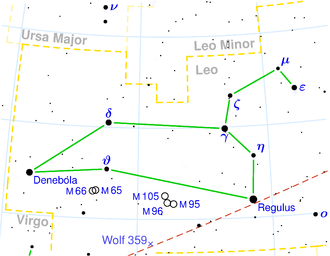NGC 3868
| Galaxy NGC 3868 |
|
|---|---|

|
|
| SDSS recording | |
| AladinLite | |
| Constellation | lion |
|
Position equinox : J2000.0 , epoch : J2000.0 |
|
| Right ascension | 11 h 45 m 29.9 s |
| declination | + 19 ° 26 ′ 41 ″ |
| Appearance | |
| Morphological type | S0 |
| Brightness (visual) | 14.4 mag |
| Brightness (B-band) | 15.2 mag |
| Angular expansion | 0.8 ′ × 0.3 ′ |
| Position angle | 85 ° |
| Surface brightness | 12.7 mag / arcmin² |
| Physical data | |
| Affiliation | Abell 1367 |
| Redshift | 0.021351 +/- 0.000043 |
| Radial velocity | 6401 +/- 13 km / s |
|
Stroke distance v rad / H 0 |
(284 ± 20) x 10 6 ly (87.0 ± 6.1) Mpc |
| history | |
| discovery | Edouard Stephan |
| Discovery date | March 23, 1884 |
| Catalog names | |
| NGC 3868 • PGC 36638 • CGCG 097-135 • MCG + 03-30-104 • 2MASX J11452991 + 1926407 • LEDA 36638 • LDCE 836 NED040 | |
NGC 3868 is a lenticular galaxy of the Hubble-type S0 in the constellation Leo on the ecliptic . It is an estimated 284 million light years from the Milky Way , has a diameter of about 65,000 ly, and is a member of the Leo galaxy cluster Abell 1367 .
The galaxies NGC 3857 , NGC 3859 , NGC 3864 , NGC 3867 are located in the same area of the sky .
The object was discovered by Edouard Stephan on March 23, 1884 .
